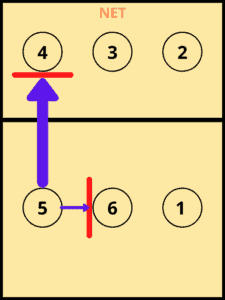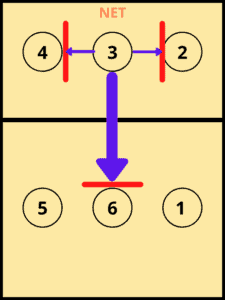There is one thing that stumps nearly every volleyball player to have ever touched the game.
This thing is Volleyball Rotations.
There are so many things that make rotations confusing such as; Rules relating to rotations, why we rotate and more importantly when do we rotate in Volleyball
There are two occasions where we rotate in Volleyball, the first occasion is when the team that is receiving wins the point from the serving team.
When this occurs the receiving team that just won the point would rotate one position clockwise. This would mean the player at the back right position would rotate to the back middle position.
The other situation is when the ball is served players on both teams may need to rotate to get to their desired positions on the court.
Now that is a very simple look at when we rotate but there is actually quite a bit more to rotating than you think.
Firstly we need to understand where we need to stand to be in the correct rotation and how we can tell when we aren’t in rotation. The other thing we need to understand is why we even rotate in the first place.
In this article I hope to cover all these points so the next time you play, you feel confident with rotations.
Table of Contents
Rotation Rules

When it comes to the rules of rotating it actually looks really confusing when you see diagrams with arrows and lines pointing everywhere, however it is actually a lot more simple than you think.
Now yes I am going to create diagrams with lines everywhere but I am going to focus on one position at a time so regardless of where you are on the court next time you play, you understand exactly who affects where you can or can’t stand.
The rules of rotation apply to players that are left, right, infront or behind you. This means players that are diagonally positioned from you don’t affect where you can stand.
To better show this I will dive into the diagrams and just to make it easy to follow I am going to start with a player in position (Zone) 1 which is the back right position on the court.
Player at Position 1

So when looking at the above diagram you can see that I have a line pointed forwards towards the player who would be at position 2 and I have a line pointing left towards position 6.
What this means is that when in this position you are not allowed to stand in front of the player at position 2 and you can’t cross to the left of the player at position 6. That is until the serve has taken place and the ball is live.
To make this easier to implement I am going to move round the positions in the same order that you would naturally rotate on court. This being a clockwise direction
Player at Position 6

This is one of the more confusing ones as you have more players to consider however again when you understand what you need to be wary of it’s easy to follow.
When standing at position 6 you will see there is a line going directly forward to the player at position 3, a line to the right back towards position 1 and a line to the left towards the player at position 5.
What these lines show is that you can’t cross in front of the player at position 3, you can’t cross to the right side of the player at position 1 and you can’t cross to the left of the player at position 5.
Player at Position 5

Moving on to position 5 you can see a line going directly forward to the player who would be at position 4 and a line going right towards to the player at position 6.
The line going forward towards the player at position 4 shows that you can not cross in front of the player at position 4. The line going towards the player at position 6 shows that you can not cross to the right side of position 6
Player at Position 4

Moving round the front court player we start at position or zone 4. When in the front row there obviously aren’t any players in front, this means we need to start worrying about the players behind us rather than in front of us. The player at zone 4 needs to be concerned about the player directly behind them at position 5 and the player to the right of them at position 3.
The arrow heading backwards towards the player at position 5 shows that you can not drop behind the player at position 5.
The line heading right indicates that you can’t cross to the right side of the player at position 3
Player at Position 3

Moving round again to the player in the front middle of the court at position 3.
This is another position in which they can technically be affected by 3 players rather than 2.
The line heading directly backwards towards position 6 indicates that the player can not drop back behind the player at position 6.
The line going right towards position 4 shows that the player can’t cross to the right side of the player at position 4.
Lastly the line going right towards the player at position 2 indicates the player at position 3 can’t go to the right side of the player at position 2.
Player at Position 2
The last position on the court and in the front row before restarting the rotations is position (or zone) 2, the front right of the court.

In this position you can see a line pointing backwards towards the player at position 1 and also a line pointing left towards the player at position 3. Obviously as we are at the front right of the court, there can’t be anybody to the right of us.
The line heading towards the player at position 1 indicates that we can’t drop behind the player at position 1.
The line heading left shows that we can’t cross to the left side of the player standing at position 3.
Hopefully breaking it down to each individual position helps you understand the ruling a little bit better, however I understand it can be a lot to take in so I want to give you a little tip to help you remember.
Rule Of Thumb To Help Remember
If you have read through all of that and you think you will struggle to remember who you need to worry about then a simple rule of thumb is as follows;
When moving along the back row, worry about the player directly in front of you and to the left of you.
When moving along the front row, think about the player to the right of you and directly behind you.
The reason this works is because the player following you will be using the same system and knows they can’t pass you so you shouldn’t have to overload your brain with where everyone else needs to stand.
Why Do We Rotate?
So now you know how and when we rotate but maybe you are still thinking.
‘Why do we even bother rotating?’
Well there are actually many different reasons as to why we rotate however the main reason is to make the game more competitive and to add a new layer of strategy into the game.
With different positions on the court and certain players boasting obvious strengths in certain areas and weaknesses in others, by adding rotations it pushes players into and out of zones of comfort constantly meaning teams must come up with innovative ways to make use of each player’s strengths.
The other main reason why we rotate after winning a point from the serving team is to give every player on the court the opportunity to serve. This is traditionally the real reason why teams rotate, however, with the progression of the sport constantly being pushed and tested it has led to new innovative tactics and boundaries being pushed.
